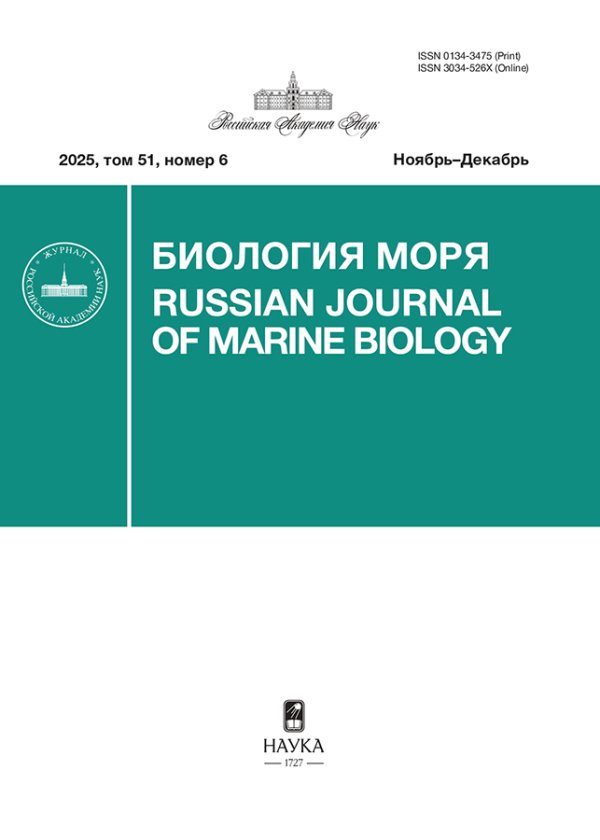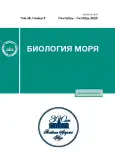Vol 49, No 5 (2023)
- Year: 2023
- Published: 01.09.2023
- Articles: 9
- URL: https://journals.rcsi.science/0134-3475/issue/view/8218
Full Issue
ОРИГИНАЛЬНЫЕ СТАТЬИ
Mycotoxins in Macroalgae from the Kandalaksha Gulf of the White Sea after Natural and Experimental Alienation from the Substrate
Abstract
Samples of macrophyte algae were collected from an ecotope of Kandalaksha Gulf, the White Sea. These algae were selected from substrates, storm wracks and after long-term storage in the soil, and they were assessed by indirect competitive enzyme immunoassay for the presence of low-molecular metabolites of micromycetes (mycotoxins). In Fucus distichus, F. serratus, F. vesiculosus, and Ascophyllum nodosum, the concentrations of all analyzed toxic substances from storm wracks were uniformly reduced compared to those in living thalli. For Laminaria digitata, Saccharina latissima and Ahnfeltia plicata, in living individuals of which mycotoxins were not found or were extremely rare, cases of contamination with citrinin, mycophenolic acid, emodin and sterigmatocystin were found in storm wracks. After 12 months of burial in soil F. distichus samples had only 9 components out of 16 analyzed. In F. serratus, F. vesiculosus, A. nodosum, and Pelvetia canaliculata, only emodin, mycophenolic acid, alternariol, and ergot alkaloids were determined.
 287-292
287-292


Macroalgal Flora Findings in Peter the Great Bay, of the Sea of Japan
Abstract
This article is one of a series of publications concerning new and little-known macroalgae of Peter the Great Bay, Sea of Japan. Our study was carried out from February, 2021 to July, 2022. A total of eight species are described, of which six are new species for this aquatic region. Three species are also newly reported for the flora of the Far Eastern seas of Russia; two species were previously noted in the bay, but not described. We provided all of these species with detailed descriptions and illustrations.
 293-302
293-302


Microsatellites and the Major Histocompatibility Complex of the Atlantic Walrus Odobenus rosmarus rosmarus (Linnaeus, 1758) in Haulouts of the Barents Sea
Abstract
The allelic diversity of the DQB gene of the major histocompatibility complex (MHC) in Atlantic walrus from the European part of the Arctic was analyzed for the first time. We studied animals from the haulouts located on the Franz Josef Land archipelago and near the northern tip of Novaya Zemlya. We demonstrated that there are significant differences for this locus between the two studied haulouts. Simultaneous analysis of microsatellite loci reveals a lower level of differentiation, and also suggest that animals from more than one spatial-geographical stock (population) gather at the summer haulout on Novaya Zemlya. It has been suggested that individuals with different MHC genotypes may prefer different feeding areas, regardless of the areas of residence during the breeding season.
 303-312
303-312


Domoic Acid in Cultures of the Diatom Genus Pseudo-nitzschia H. Peragallo in H. Peragallo & M. Peragallo, 1900 and in Bivalve Samples from the Russian Waters of the Sea of Japan and the Pacific Waters of Kamchatka
Abstract
Content of a dangerous amnesic toxin – domoic acid (DA) – was determined in cultures of the diatom genus Pseudo-nitzschia and in bivalve samples collected in the Russian waters of the Sea of Japan and off the Pacific coast of Kamchatka. For the first time, the presence of DA has been confirmed in cultures of Pseudo-nitzschia pungens (Grunow ex Cleve) G.R. Hasle, 1993 and P. delicatissima (Cleve) Heiden, 1928 from the Pacific coast of Kamchatka with the use of the competitive enzyme-linked immuno-sorbent assay (cELISA). Relatively high concentrations of DA were recorded in the horse mussel Modiolus kurilensis F.R. Bernard, 1983 (2.92 mg/kg based on high-performance chromatography-mass spectrometry (HPLC-MS) and 2.8 mg/kg based on cELISA) and in the Gray mussel Crenomytilus grayanus (0.07 mg/kg based on HPLC-MS and 0.2 mg/kg based on cELISA) collected in the Sea of Japan. It has been shown that for assessing relatively low concentrations of amnesiotoxin (less than 5 ng/ml in microalgal cultures and less than 0.05 mg/kg in mollusks) cELISA assay is an alternative to HPLC that does not allow to detect DA in such samples.
 313-318
313-318


Biological Features of Atlantic Cod Gadus Morhua L., 1758 (Gadiformes: Gadidae) of the Murmansk Coast: Race Composition and Fishing
Abstract
The biological features of Atlantic cod in the coastal zones of the Murman for 1999–2006 were studied. The age composition, growth rate and maturation, feeding habits and structure of otoliths were analyzed. Histological and genetic studies were carried out. It was shown that young cod mainly lives and spawns in Western Murman bays. Older cod leaves the bays due to insufficient food supply. The growth rate of young coastal cod is comparable to that of cod in the open part of the Barents Sea. With age, the cod of open sea areas noticeably overtakes the cod that lives in the coastal zone in growth. It was noted that cod spawns in the bays with both coastal and Atlantic types of otoliths. Studies of genetic polymorphism indicate a high degree of genetic si-milarity between cod groups in the Norwegian and Barents Seas, which is evidenced under the influence of currents (branches of the Norwegian Atlantic Current, the Murmansk Coastal Current) and against the background of migrations at different stages of ontogeny of cod individuals from coastal and open water areas.
 319-332
319-332


Colonial Nesting Sea Birds (Charadriiformes: Laridae) of Peter the Great Bay, the Sea of Japan
Abstract
The paper presents the recent data on the distribution and breeding abundance and distribution of the Mongolian Gull, Slaty-backed Gull, Black-tailed Gull and the Common Tern nesting within Peter the Great Bay of the Sea of Japan. Over the past 30 years, all species of gulls increased their abundance, while the Common Tern has almost ceased to nest on the islands of the bay.
 333-339
333-339


Recent Variations in the Size and Age Structure of the Population of Horse Mackerel Trachurus mediterraneus (Steindachner, 1868) on the South-Western Shelf of Crimea
Abstract
The influence of the average annual sea surface temperature (SST) on the development of horse mackerel Trachurus mediterraneus on the south-western Crimean shelf has been shown. The changes in the main indicators of the population and their relationship with the change in the average annual SST (0.055°C/year) in 2000–2020 have been identified. Against the background of the observed increase in SST in recent years, the state of the horse mackerel population has improved: there has been an increase in the average age and, accordingly, the proportion of larger, well-fed individuals, and, in general, the average size and weight of fish. It has been shown that according to the nature of the change in the average annual SST, three periods can be distinguished: 2000−2007, 2008−2013 and 2014−2020.
 340-348
340-348


КРАТКИЕ СООБЩЕНИЯ
A Case of Detection of Trematode Metacercaria Pygidiopsis Looss, 1907 in the mollusc Hydrobia acuta (Draparnaud, 1805) in the Black Sea
Abstract
Five specimens of encysted trematode metacercariae of Pygidiopsis Looss, 1907, located outside the tissues of the host, in a free state, were found in the extrapaleal cavity of the gastropod mollusc Hydrobia acuta (Draparnaud, 1805) from Cossack Bay (Black Sea). A figure, an image, and measurements of excisted larvae were given.
 349-352
349-352


The Disease of the Scallop Mizuhopecten yessoensis (Jay, 1857) in the Mariculture Farms of Prymorye Caused by Protozoa of the Genus Perkinsus Levine, 1978
Abstract
The results of a study of the cultivated yesso scallop Mizuhopecten yessoensis (Jay, 1857) in Primorsky Krai in 2014–2021 are presented. The death of molluscs in mariculture farms was noted, the symptoms of the “dermo” disease were studied: high mortality of scallops that have reached two years of age, observed during autumn displacement into new cages in September, the presence of protozoa of the genus Perkinsus Levine, 1978 in the tissues of organs, foci of damage of the adductor muscle, non-closure of the shell valves, black discoloration, necrotizing of soft tissues. The minimum level of the parasitic load was established: 10–15 pa-rasitic hypnospores per mollusc. However, considering the danger of a disease that causes mass death of molluscs for several years, the rapid spread of the pathogen, significant economic losses, it is recommended to create a specialized laboratory in the region for diagnosing and constantly monitoring the state of mariculture farms.
 353-358
353-358












